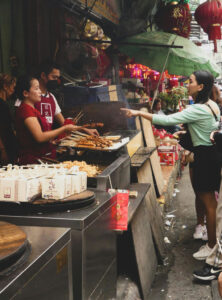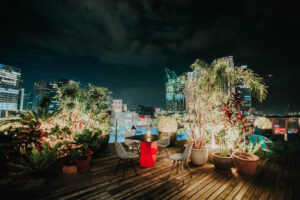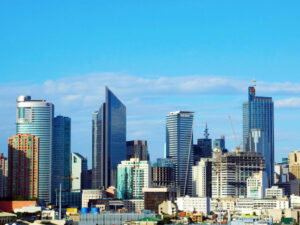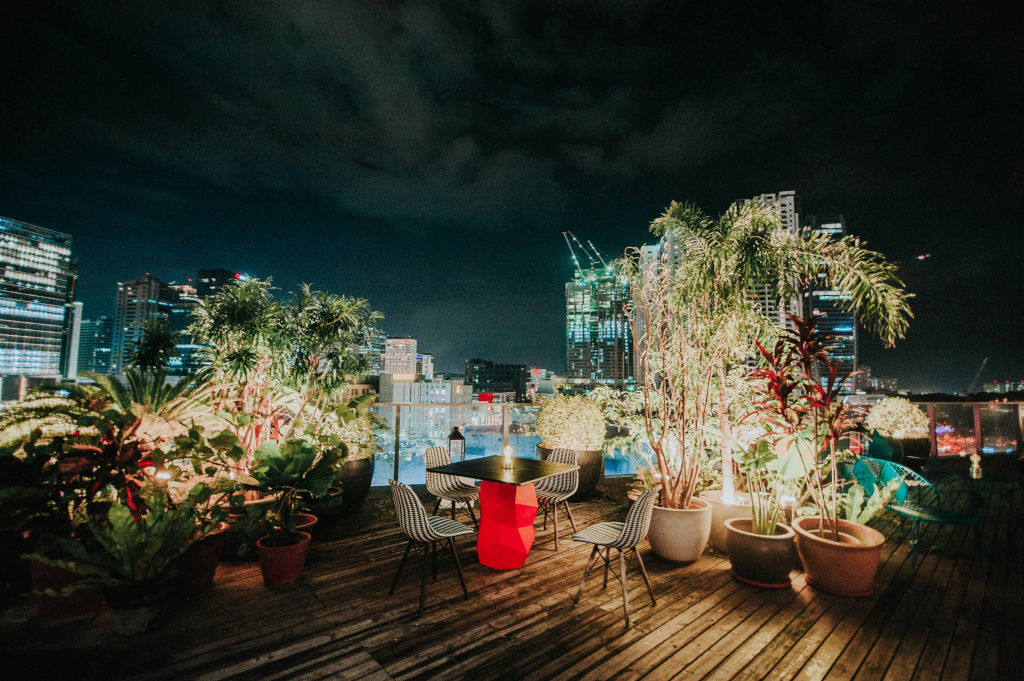There’s a particular kind of magic that unfolds when the sun dips below the Manila skyline — a shift in rhythm, a soft hum that grows into music, laughter, and the clinking of glasses. For all its chaos by day, Manila transforms after dark into something else entirely — a city of color, heat, and life. I’ve spent countless evenings tracing that transformation, chasing sunsets and street food, rooftop lights and quiet corners. This story is my love letter to Manila nightlife — its beauty, its contradictions, and its pulse that never seems to fade.
Golden Hour Beginnings
I always start with the sunset. There’s no better introduction to Manila nightlife than watching the city turn gold from above. My favorite perch? The Penthouse 8747 in Makati — an Art Deco-inspired rooftop that feels like stepping into a Gatsby novel. The city sprawls below in warm light as jazz hums softly through the speakers. I ordered their signature “Mr. Grey” cocktail — a mix of gin, earl grey syrup, and citrus — smooth, fragrant, and perfectly suited for twilight reflection.
A few blocks away, the Sky Deck View Bar atop The Bayleaf Intramuros offers a different kind of view — historic rooftops, church domes, and the faint outline of Manila Bay in the distance. As I leaned on the railing, I could hear faint echoes of church bells mixing with laughter from nearby tables. When the wind carries the scent of salt from the bay, it’s easy to forget the traffic below.
For something glitzier, The Peak at Grand Hyatt BGC feels like the city at its most cosmopolitan — panoramic views, velvet booths, and live jazz that rolls deep into the night. Watching Manila’s skyline from there, a glittering sea of lights and motion, I realized that the best sunsets are the ones that give way to stories waiting in the dark.
Street Food Stories
 But if rooftop bars are Manila’s poetry, its heart beats in the streets. I left the high-rises behind for the smoky aroma of Mercato Centrale in BGC — a night market that feels like a festival every weekend. The air was thick with the smell of grilled meats, garlic rice, and sweet barbecue glaze. I tried isaw (chicken intestines skewered and charred to perfection), liempo dripping with savory fat, and halo-halo served in tall cups under string lights. Around me, strangers shared tables, laughter mingling with the rhythm of live acoustic bands.
But if rooftop bars are Manila’s poetry, its heart beats in the streets. I left the high-rises behind for the smoky aroma of Mercato Centrale in BGC — a night market that feels like a festival every weekend. The air was thick with the smell of grilled meats, garlic rice, and sweet barbecue glaze. I tried isaw (chicken intestines skewered and charred to perfection), liempo dripping with savory fat, and halo-halo served in tall cups under string lights. Around me, strangers shared tables, laughter mingling with the rhythm of live acoustic bands.
Next, I wandered into Poblacion, Makati’s bohemian neighborhood, where every alley hums with life. Here, Manila nightlife comes unfiltered — raw, colorful, and endlessly creative. I stopped at a small stall called Tambai for skewers and local craft beer, its bar stools spilling onto the sidewalk. Across the street, neon lights glowed from Agimat Foraging Bar, where bartenders mix cocktails inspired by Philippine folklore — drinks served with fire, smoke, and a touch of theater.
Later, I found myself in Binondo, the world’s oldest Chinatown, where the food never seems to sleep. Down Ongpin Street, vendors sold steaming siopao, dumplings, and machang until midnight. I stood in line at a dimly lit stall for fried siopao — crisp on the bottom, pillowy on top, filled with sweet-savory pork. The taste took me back to childhood field trips and family dinners, proof that Manila’s flavors always find their way home.
Drinks with a View
 As the night deepened, I returned to Makati — where rooftops and hidden bars keep the pulse of Manila nightlife alive long after midnight. At The Curator Coffee & Cocktails, the dual identity of café by day and speakeasy by night sets the tone for modern Manila — adaptive, stylish, and personal. I sat at the bar, watching the bartender craft a drink with coconut syrup and calamansi. He called it “Isla,” and it tasted like the tropics meeting the city’s restless soul.
As the night deepened, I returned to Makati — where rooftops and hidden bars keep the pulse of Manila nightlife alive long after midnight. At The Curator Coffee & Cocktails, the dual identity of café by day and speakeasy by night sets the tone for modern Manila — adaptive, stylish, and personal. I sat at the bar, watching the bartender craft a drink with coconut syrup and calamansi. He called it “Isla,” and it tasted like the tropics meeting the city’s restless soul.
In BGC, Yes Please captures a different vibe — neon pink lights, 90s playlists, and cocktails with playful names like “Walang Forever.” It’s where office workers unwind, couples dance in corners, and travelers share stories that start with “I just got here.” Every drink comes with a laugh, every toast with a story.
And then there’s The Spirits Library, tucked in Poblacion — walls lined with bottles like a museum of liquid art. I remember sitting there under warm amber light, talking to a local musician about Manila’s evolving art scene. “We survive through rhythm,” he said, lifting his glass. “That’s what this city does best.”
After-Hours Manila
By midnight, the energy shifts. The city doesn’t slow down — it transforms. Karaoke bars start to fill up; the familiar hum of laughter and off-key singing spills into the streets. In Malate, I joined a group of locals in a tiny videoke bar. Someone sang “Bakit Pa?” with heartfelt passion, and the crowd clapped like it was a concert. It’s impossible not to join in — Manila doesn’t let you be an observer for long.
When I needed a breather, I found myself at Run Rabbit Run in Poblacion — a quiet haven with garden lights and creative cocktails that taste like stories. Their “Pom Before the Storm,” made with gin, pomelo, and calamansi, was both sweet and strong — much like the city itself. I sat in the courtyard, listening to the chatter around me, realizing that Manila’s nightlife is more than a collection of bars — it’s a network of moments that connect strangers through rhythm and flavor.
For something calmer, I sometimes end my nights at a 24-hour café like Wildflour or Commune, where writers, artists, and night owls linger over cappuccinos and quiet conversations. The city may never sleep, but it knows how to dream.
Mika’s Reflections: The Pulse of Manila After Dark
 There’s a particular honesty that surfaces when the lights dim. The daytime armor — suits, schedules, routines — falls away, and what’s left is the real Manila: warm, unpredictable, and full of heart. You see it in the way a bartender listens to a stranger’s story, in the way a street vendor remembers your order, or in the spontaneous laughter that fills a jeepney at 2 a.m. Manila may be imperfect, but it’s alive in ways few cities are.
There’s a particular honesty that surfaces when the lights dim. The daytime armor — suits, schedules, routines — falls away, and what’s left is the real Manila: warm, unpredictable, and full of heart. You see it in the way a bartender listens to a stranger’s story, in the way a street vendor remembers your order, or in the spontaneous laughter that fills a jeepney at 2 a.m. Manila may be imperfect, but it’s alive in ways few cities are.
What I love most about Manila nightlife is how it mirrors the city itself — a beautiful chaos that somehow works. One moment you’re in a rooftop bar sipping champagne, and the next, you’re sitting on a plastic stool eating lugaw beside construction workers and students. There’s no hierarchy here, just shared space, shared time, and shared hunger — for flavor, for connection, for life itself.
As dawn approached, I found myself walking near Roxas Boulevard. The horizon was pale pink, and the city’s noise softened to a hum. Street sweepers replaced bar-goers, vendors prepared for morning, and the sea breeze carried the faint scent of coffee and salt. Manila, I thought, doesn’t end — it resets. Every night here is a story; every sunrise, a new beginning.
For more experiences that capture the city’s spirit, explore 33 Best Things to Do in Manila – Unforgettable Experiences in the Heart of the Philippines, or check out nightlife spots and tours on Time Out Manila for up-to-date events and recommendations.
Manila isn’t a city you simply visit — it’s one you feel, especially after dark. When the lights flicker on and the music starts, you begin to understand: this city lives in moments — fleeting, vivid, and impossibly alive.

